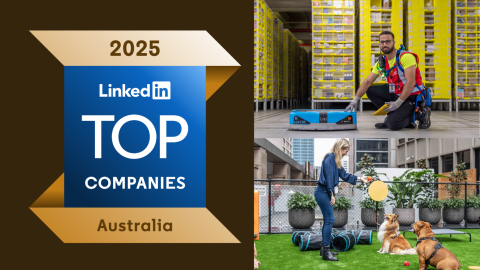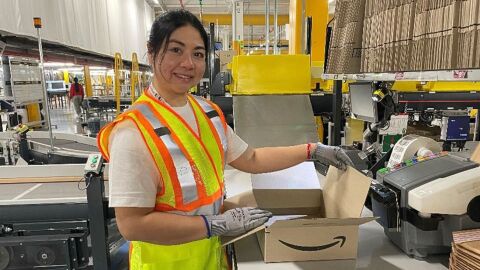At Amazon, we believe that our ability to innovate on behalf of our customers relies on the perspectives and knowledge of people from all backgrounds. We actively recruit and develop people from diverse walks of life to build a supportive and inclusive workplace, and take steps to ensure employees have a sense of belonging, value, and opportunity. This culture of inclusion is reinforced within our 16 Leadership Principles, which remind team members to seek diverse perspectives, learn and be curious, and earn trust. Creating a diverse workforce is a journey that we are all on, and our goal is to continue to provide a range of initiatives that diversify the talent pool by inspiring young women to study Science, Technology, Engineering, and Mathematics (STEM) subjects, and helping women of all ages to consider and develop a career in technology.
This year, the Workplace Gender Equality Agency in Australia is publishing the median gender base salary and total remuneration pay gap of all Australian companies with 100 or more employees. Amazon’s latest results are above industry benchmarks, and we are proud of our strong female leadership—in fact in Australia and New Zealand, our Operations, Amazon.com.au, AWS and Alexa organisations all have women leaders. But we acknowledge that there is still work to be done within our business, and we are committed to continuing to create a more diverse workforce.
What is the difference between gender pay gap (GPG) and equal pay?
GPG compares the average pay of all working men and women, regardless of their job title, level, working patterns, organisation levels, qualifications, or experience. GPG is an expression of the difference in the overall average earnings between all men and women within an organisation. Equal pay, on the other hand, ensures that people receive equal pay for equal work, regardless of their gender. Therefore, the presence of a GPG does not mean that there is a difference in pay for men and women in the same roles.
Amazon Australia’s gender pay gap reports are available here.
Continuing our focus on substantive equality in the workplace, Amazon supports a wide range of initiatives to inspire, recruit, and develop women and non-binary talent.
Inspiring more girls and women into technology and leadership roles
Amazon has a series of educational programs, apprenticeships, and events that aim to help inspire more girls and women to consider computer science and technology careers. These include:
- AWS GetIT, a global education program and competition designed to introduce 12 to 14-year-old students, especially young women, to digital skills and inspire them to consider a career in technology.
- Women in AI, an initiative providing education, research, and events to inspire women towards inclusive AI, and to become AI and data experts, innovators, and leaders
- She Builds, AWS-sponsored program aimed at challenging, motivating, inspiring, and empowering women to enter the technology sector by offering a number of initiatives including a 12-week external mentorship program, career development program, and a tech skills program to increase cloud skills, which also has a monthly live Twitch stream to showcase our female builders.
- CloudUp for Her, a flexible learning pathway that helps set women up for success in their cloud learning journey, now also incorporating the Art of the Possible with Generative AI and pathways designed for women who want to build Solution Architect Skills. CloudUp for Her Community based self-paced training can lead to certifications for Cloud Practitioner and Associate Solution Architects.
- Girls Tech Day, a global initiative that was established in Australia in 2019 to provide free Science, Technology, Engineering, Arts and Maths (STEAM) learning with activities designed to engage, connect and activate future female innovators in coding, robotics, cloud computing, problem-solving, and more.
- Think Big Space, Sydney, a dedicated learning environment to cultivate a greater interest in STEAM by providing students, in particular young girls, educators, and communities with hands-on, technology-led lessons and activities to explore STEAM-related careers. The space launched at Sydney’s Blacktown Girls High School.
Upskilling opportunities
Amazon is committed to simplifying access to technology careers for all. Since 2017, AWS has proudly trained more than 300,000 people in Australia on cloud skills. In 2020, AWS launched AWS re/Start in Australia. AWS re/Start is a free, cohort-based workforce development training program that helps individuals build cloud computing skills and connects participants with employment opportunities at local employers. The program works with collaborating organisations to offer a learning experience, provide a pathway to AWS Certification, and support learners as they launch their cloud careers. It’s designed to accommodate differing levels of experience—even those with no previous technical knowledge can apply. Globally, the AWS re/Start program connects more than 98% of graduates with job interview opportunities.
Creating the right environment for an inclusive culture
To cultivate a community of inclusion amongst our employees, we recognise that we need to recruit a diverse pool of talent and ensure we are nurturing and developing the employees already at Amazon. We are committed to creating a diverse organisation where people thrive, and to giving our employees the support they need to do their best.
Amazon employees in Australia receive up to 20 weeks of paid parental leave, including superannuation contributions. Eligible primary caregivers can access 14 weeks of paid birth or adoption leave from their first day of work, and both eligible primary and secondary caregivers, who have worked at Amazon for at least 12 months, qualify for up to six weeks of paid parental leave. In addition, Amazon offers access to fertility and family-building services as well as subsidised health insurance to support reproductive, pregnancy and birth-in-hospital treatments.
Our employees are also enabled to build their work arrangements around family commitments—corporate employees have a hybrid-work model, while warehouse workers work four-day condensed weeks, with different shift times available.
Supporting a diverse range of communities
Amazon has 13 affinity groups, also known as employee resource groups. They play an important role in bringing Amazon employees together and creating a sense of community globally, while encouraging inclusivity and diversity. Women at Amazon and Amazon Women in Engineering are two of several groups which have chapters dedicated to attracting, developing and retaining women in technology roles, and discussing a wide range of topics such as career development and demystifying promotion processes, menopause, fertility, pregnancy loss, and work life harmony. This year the group has played an active role in driving #InspireInclusion, with a focus on collaborating closely with Glamazon (our LGBTQIA+ network). Find out more about our Amazon affinity groups here.
We are also proud of our other programs for employees, such as:
- AmazeCon, a diversity-focused conference to support all managers in developing an inclusive and diverse workforce.
- Amazon Mentoring Circles, a program that matches volunteer mentors in Amazon with employees who are seeking guidance in their careers.
- AWS Community Events, which bring together a range of inspirational speakers to provide guidance, develop skills and initiate networking opportunities while discussing key topics including artificial intelligence, machine learning, data science, and beginning a startup.
- Listening circles, a safe space for women working within Amazon’s Operations network to give and get advice, discuss challenges and solutions, and celebrate wins.
- National Association of Women in Operations membership, an initiative that provides all employees access to benefits for women and men, such as mentoring, and helps them build their careers in operations.
Find out more about diversity, equity and inclusion at Amazon.
All references to Amazon’s gender pay gap refer to the 1 April 2022 to 31 March 2023 reporting period.











